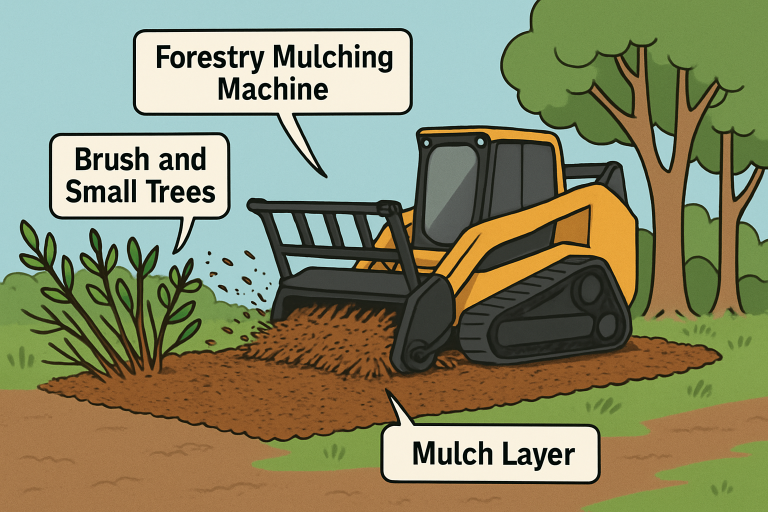News
How Forestry Mulching Supports Sustainable Land Management

Key Takeaways
- Forestry mulching clears vegetation efficiently while enriching soil and preserving topsoil.
- Supports biodiversity by promoting native flora and fauna and controlling invasive species.
- Reduces wildfire risk and creates defensible spaces around properties.
- Minimizes land disturbance compared to traditional clearing methods, protecting ecosystems.
- Offers long-term cost savings and enhances property value through sustainable land management.
What Is Forestry Mulching?
Forestry mulching is a modern land management technique that involves using specialized machinery to cut, grind, and clear vegetation, such as trees, brush, and undergrowth, in a single step. The process turns organic material into mulch, which is left on the ground to decompose and enrich the soil. Common equipment includes forestry mulchers, skid steers with mulching attachments, and tracked vehicles designed to navigate varied terrain with minimal impact. These methods are rapidly gaining popularity as efficient alternatives to traditional land clearing practices.
Landowners seeking to improve their property’s health while preserving the environment can benefit from targeted solutions like forestry mulching in Charles Town. This approach streamlines land management and balances usability and ecological responsibility by retaining valuable topsoil and minimizing disturbance to the area.
The Environmental Benefits of Forestry Mulching
One of the chief advantages of forestry mulching is its ability to reduce soil erosion and surface runoff. By converting cut vegetation directly into mulch, the process creates a natural barrier that protects the soil from the erosive effects of wind and water. This mulch layer keeps topsoil intact and reduces the likelihood of sediment entering nearby waterways, which is vital for aquatic ecosystem health.
Forestry mulching directly enhances biodiversity on managed lands. By selectively removing invasive species and promoting a varied plant community, this process creates conditions favorable to native flora and fauna. Maintaining diverse habitats also supports pollinators and other wildlife critical to ecosystem resilience.

How Forestry Mulching Promotes Soil Health
Integrating mulched vegetation into the land returns essential organic material to the ecosystem, boosting the natural cycle of nutrients. As the mulch decomposes, it feeds the soil with carbon and nutrients, fostering the growth of robust plant communities. This organic layer also supports beneficial microbial activity, enhancing soil fertility.
Forestry mulching prevents soil compaction using lightweight or low-impact machinery that exerts less pressure on the ground than traditional methods. This improves water infiltration and reduces the likelihood of runoff, particularly on sloped terrain. As a result, the land retains more moisture and supports healthy root development for native plants.
Wildfire Prevention and Risk Management
A crucial benefit of forestry mulching is its role in wildfire prevention. By reducing the “fuel load”—or the volume of flammable brush and undergrowth—mulching lowers the risk and intensity of wildfires. Managed landscapes are less likely to experience uncontrolled burns, helping to protect properties and surrounding forests.
Mulching also plays a pivotal role in creating defensible spaces around homes and infrastructure. Maintaining these buffer zones has dramatically increased a property’s chances of surviving wildfires.
Sustainable Land Clearing Methods Compared
Forestry mulching is often preferred over traditional land clearing methods—such as bulldozing, burning, or hauling away debris—because it minimizes disturbance to the land. Traditional techniques typically remove all vegetation and topsoil, disrupt soil structure, and require significant remediation to restore ecological balance. In contrast, mulching selectively clears overgrown areas, converts biomass on-site, and helps maintain the existing soil structure.
Mulching minimizes disturbance, benefiting local ecosystems by reducing habitat loss and preserving the integrity of the landscape. This method enables landowners to achieve management objectives without sacrificing long-term land health or ecosystem services.
Supporting the Health of Native Flora and Fauna
Selective clearing with forestry mulching creates conditions where native plant species can thrive. By controlling invasive species and opening up the canopy, mulching encourages the resurgence of native grasses, shrubs, and trees. This, in turn, provides better-quality food and shelter for local wildlife.
The process also preserves important wildlife corridors and habitats. With less disruption than clear-cutting, animals are more likely to maintain existing movement patterns and access vital resources, supporting a balanced and thriving environment.
Cost-Effectiveness and Long-Term Value for Landowners
Forestry mulching delivers substantial savings compared to traditional land clearing. While there may be a higher up-front investment for equipment or service, ongoing maintenance is typically much lower. The mulch left on the ground suppresses invasive plant regrowth, reducing the need for repeated clearing or herbicide use.
Sustainable land management practices like forestry mulching can also enhance property values. Well-maintained landscapes, healthy ecosystems, and protection against erosion or wildfire risk are attractive features that can improve the long-term worth of the land.
Steps Landowners Can Take to Implement Forestry Mulching
Initial Assessment and Goal Setting
The journey toward sustainable land management begins with a thorough assessment of your property. Determine what you hope to achieve—fire risk reduction, habitat restoration, improved access, or another objective. Identify areas with overgrown brush, invasive species, or soil health issues.
Choosing a Service Provider and Project Planning
Select a reputable forestry mulching service with work experience similar to your needs. Effective providers will offer clear guidance, project timelines, and transparent pricing, ensuring the work aligns with ecological goals and budget. Discuss the project scope, including which areas to clear and any specific concerns related to sensitive habitats or water sources.
Monitoring and Maintaining Sustainability
After mulching, continue to monitor your land’s condition. Look for signs of native species regrowth, soil stability, and reduced weed pressure. With periodic maintenance, forestry mulching can yield long-lasting improvements and keep property in optimal condition for years.
Embracing Sustainability Through Modern Land Management
Forestry mulching reshapes how landowners approach stewardship, offering a sustainable and efficient alternative to traditional clearing. Its benefits are expansive—from reducing erosion to supporting biodiversity, enhancing soil health, and mitigating wildfire risk. By balancing environmental preservation with land usability, forestry mulching empowers property owners to maintain productive, attractive, and resilient landscapes. Embracing this modern method is important in sustainable land management and responsible land ownership.
